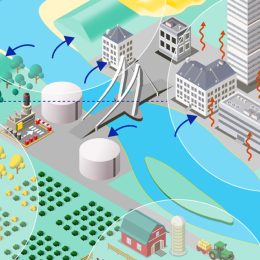Seven take-aways from the IPCC WG-I Report on Global Climate Change
Today, the Intergovernmental Panel on Climate Change (IPCC) released the first Working Group contribution of its 6th Assessment Report (AR6) on climate change. Working Group I focused on the current state of the climate, how human influence is changing it, and possible global pathways for the future. The report echoes the overwhelming scientific consensus that even the lowest emission scenario will expose communities across the globe to more extreme climatic events. Curious what the IPCC report means for water and subsurface? Read now the seven take-aways of the experts of Deltares?
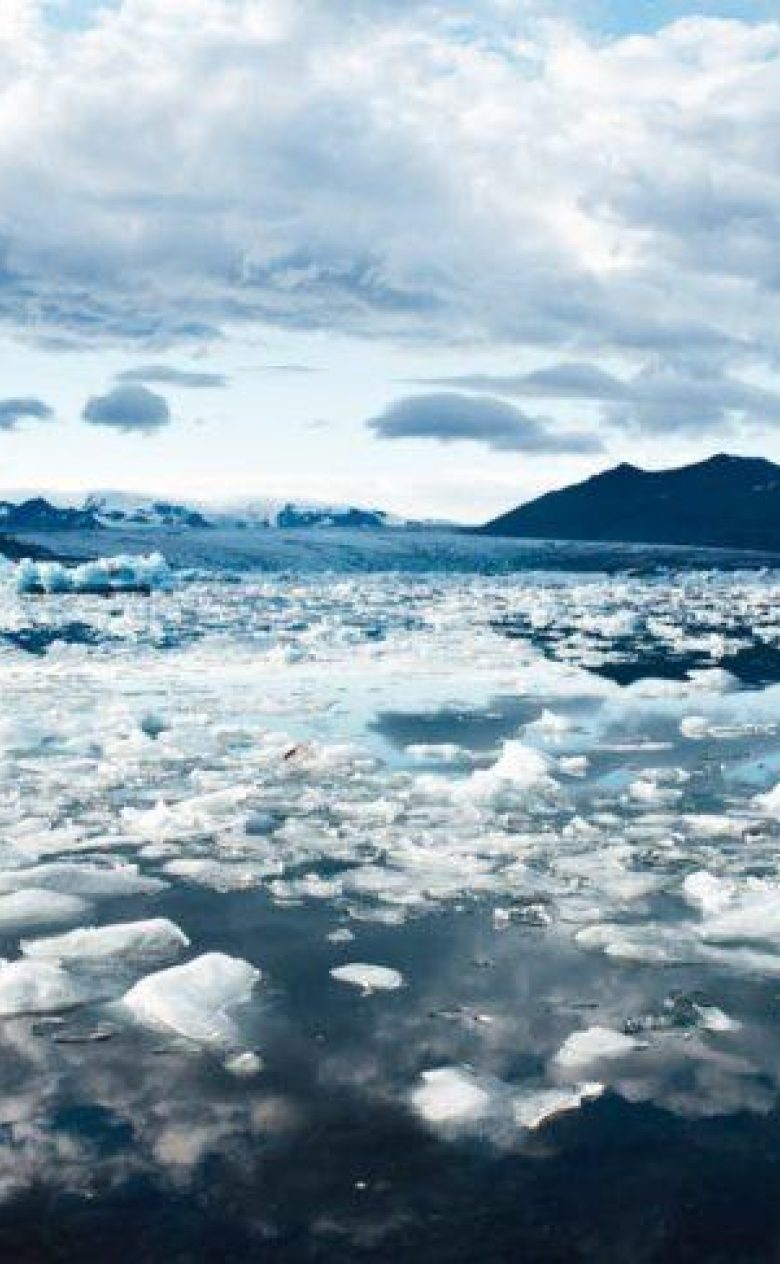
The IPCC Assessment Reports are globally recognised as the most comprehensive assessments on the state of climate science. The AR6 combines the scientific expertise of 721 authors and an additional number of contributing authors from 90 different nationalities, including six experts affiliated to Deltares, and experts from e.g. KNMI, NIOZ, IHE Delft, UU and WUR. That’s why Deltares takes stock of the WG-I report published earlier today, diving into seven take always and their implications for ourselves and the water & subsurface sector we’re working in.
Deltares draws seven lessons from this new report
Takeaway 1 – Climate change is already going on everywhere
Although climate change is often combined with “future”, “threats” or “preparing”, climate change is happening now. We are currently at a global temperature of 1.1°C above pre-industrial levels. As a result, climate change is already affecting every region in the world. From repeated heatwaves and droughts to disrupted rain patterns and wildfires, extreme events are now part of everyday’s vocabulary. What’s more, the report confirms that human influence is contributing to much of this extreme weather.
Bart van den Hurk, climate scientist at Deltares: “For nobody on this planet climate change is a remote thing. It’s visible everywhere, and every person has a high chance of experiencing its effects. So it’s part of every project that Deltares is involved in.”
Takeaway 2 – Climate change will not stop
As the global temperature is rising, many of the changes in the climate system are set to become more prominent. Even an optimistic scenario of a 1.5°C global temperature increase would mean a higher frequency of extreme weather events. And for every additional fraction of global warming, the intensity of temperature, precipitation and drought extremes will become more severe. This means higher temperature peaks, longer dry spells and more extreme rainfall. The report indicates that for many weather types the increases in extremes will be proportional to the global temperature increase. In some regions the relative increases in temperature can be up to 2-3 times the rate of global warming due to local feedbacks.
The figures from the AR6 Summary for Policy Makers represent the frequency and intensity of extreme temperatures, precipitation, and drought that occur on average once every 10 years, both in preindustrial times, the current climate and for different levels of future warming. The warmer the earth gets, the more common and severe these events will become. Already today heatwaves, floods, and droughts have become worse and more frequent than before, and this trend will continue.
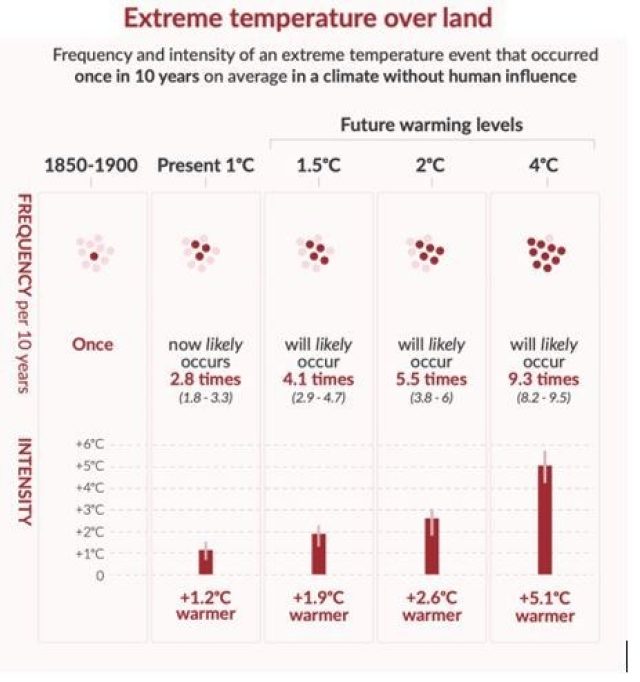
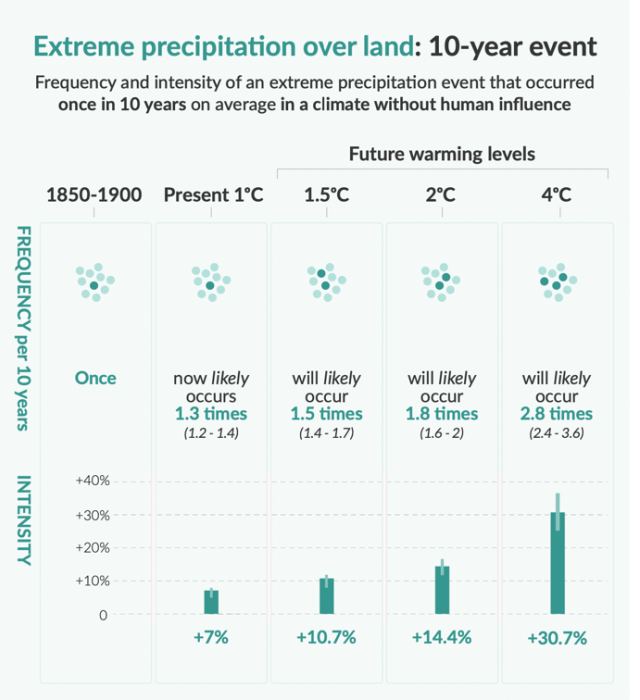
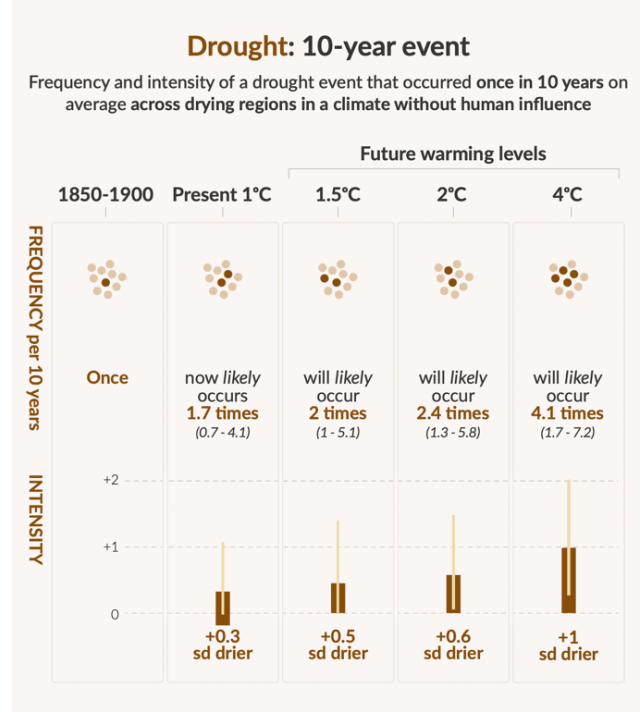
Takeaway 3 – It’ll be more wet and more dry
As global surface temperatures increase, changes in the water cycle will intensify, increasingly disrupting rain and river discharge patterns. The graph above shows that global warming will entail both extreme rainfall and extreme droughts. What is more, this effect will spread across larger regions, with an increasing area of land experiencing serious disruptions of rainfall patterns. This means that more people’s homes will be at risk of flooding, while farmers globally will also face dire growing conditions more often.
Roshanka Ranasinghe, expert on coastal impacts of climate change and affiliated to both Deltares and IHE Delft: “This AR6 report advances on the AR5 report by providing extensive regional assessment and an Atlas with global and regional information about climatic drivers that have an impact on society and ecosystems. It can be used for further climate impacts and adaptation assessments.”
Takeaway 4 – Higher global sea levels
Our future is already shaped by climate change. Even with a net halt in carbon emissions, the greenhouse effect will continue to make the global thermometer rise before it stabilises. Glaciers and ice sheets will continue to melt for at least several decades. This means that sea levels will continue to rise throughout the 21st century and beyond, changing coastlines and seriously altering flood risk in large regions worldwide. The likely range of sea level rise by 2100 for the 5 explored emission scenarios ranges between approximately 0.3 and 1 m, but the report doesn’t rule out the possibility of global mean sea level approaching 2m during the current century, when a number of low likelihood high impact outcomes like the rapid collapse of the Antarctic and Greenland ice sheets are taken into account.
Projections of sea level rise that will “likely[1]” occur for the indicated emission scenarios. For 2150 the likely sea level rise reaches up to approximately 1.9 m for the high emissions scenario SSP5-85, but values of up to 5 m cannot be ruled out.
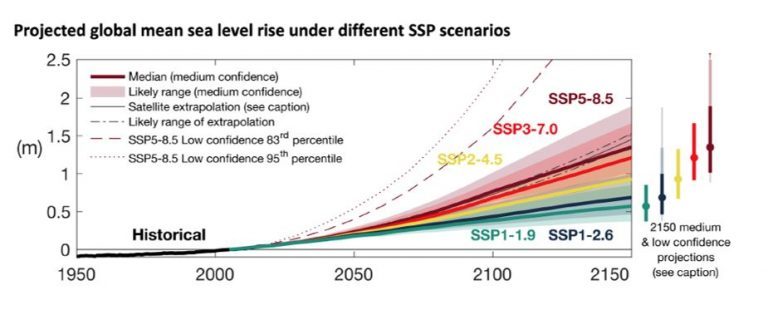
Takeaway 5 – Natural variability can lessen or worsen our impact
AR6 very explicitly states that humans have an influence on the level of warming and records of extreme weather experienced over the past century. However, natural climate variability can cause the climate to be different than its long-term trend. In some regions or episodes this can both intensify or obscure the human-driven climate trends. This implies that we should not only worry about the expected changes on the long term, but can expect unprecedented events even today.
Takeaway 6 – Every region will experience concurrent and multiple climate effects
Many regions will see an increase of multiple climate risks simultaneously. Sometimes extremes will coincide to create more harmful events. But we need to be aware that in most regions changes will occur to extreme temperatures and precipitation and drought characteristics and forest fires and coastal floods and coastal erosion etc. Some areas are more prone to such concurrent climate events than others. Urban areas are generally warmer than their surroundings and also absorb less rainwater increasing rainfall and runoff intensity. Delta regions face enhanced exposure to changing river discharge patterns and sea level rise impacts. The Dutch delta is no exception
Marjolijn Haasnoot, climate adaptation specialist at Deltares: “Adaptation is inevitable. The observed and projected increase in frequency and intensity of multiple extreme events will require huge efforts and innovative solutions to reduce adverse impacts, for instance from sea level rise in low lying countries.”
Takeaway 7 – Coastal impacts are significant
Different from previous assessment reports AR6 also systematically maps coastal impacts of climate change. Not only relative sea level, but also coastal flood, coastal erosion, marine heatwaves and ocean acidity are projected to increase with high confidence almost all over the world when the warming continues. Given that 10% of the world's population and 15 of the world's 20 megacities live in low elevation coastal zones (less than 10m above mean sea level), these reported changes have major global implications for adaptation. For sure a key topic for Deltares.
So, what’s next?
The IPCC WG-I report is published in time for the upcoming COP26 in Glasgow this November. The report shows that there is much work to be done to limit human impact on climate. And that societies need to limit further warming and adapt to the consequences of climate changes that are already in motion.
In February and March 2022, the IPCC will release two more assessment reports. Working Group II is working on society and nature’s past and future vulnerabilities to climate change and options for adaptation and climate resilient developments. Working Group III focuses on the range of mitigation options and solution pathways. Deltares is proud to have its experts contribute to this crucial assessment, carrying out research to help decision-makers better face vulnerabilities to climate change related to the field of water and subsurface.
From Deltares the following experts contributed to the AR6 report:
- Roshanka Ranasinghe (Coordinating Lead Author for WG-I)
- Bart van den Hurk (Lead Author for WG-I)
- Marjolijn Haasnoot (Lead Author for WG-II)
- Johan Reyns (Contributing Author for WG-I)
- Sadie McEvoy (Chapter Scientist and contributing author for WG-II)
- Gundula Winter (Contributing Author for WG-II)
This news item is co-produced by Deltares and the European research project RECEIPT.

